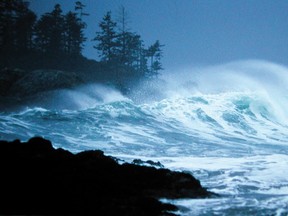The ocean water in the Pacific Northwest is more vulnerable to rapid acidification, where the carbon dioxide levels are naturally higher.

B.C. scientists are a step closer to understanding why ocean acidification is more extreme during some parts of the year in the northern Strait of Georgia.
The findings have implications for the shellfish industry and provide insight on where climate mitigation strategies, like farming kelp will be most needed.
The eight-year study involved 19 B.C. scientists, including Wiley Evans, lead oceanographer at the Hakai Institute based in Campbell River.
He said their research shows that between 2018 and 2020 weak storm seasons correlated with extreme ocean acidification, which makes sea water highly corrosive to calcium carbonate minerals used by shell-forming organisms.
Strong storm seasons like the one in 2023 led to better conditions due to increased gas exchange and freshwater influx.
“In the winter storm season winds are blowing up the straight from the southeast. So we add up that southeast wind as you go from the start of the storm season, the first day of gale force winds, to when the winds actually start to change direction and blow towards the south, which happens in the spring and summer, the end of storm season,” he said.
“Then we noted that there’s a relationship between how stormy the storm season is and what the ocean acidification parameters look like in the northern part of the strait.”
During the weaker storm years, the sea water was extremely corrosive for calcium carbonate minerals used by shell forming organisms like clams, oysters and muscles than is usually present just below the surface layer of water, which is down to about 50 metres, he said.
“What is changing is the amount of natural carbon that stays in the water. During strong storm seasons, it’s really windy, and so there’s more exchange between ocean and atmosphere,” he said.
“When it is a very strong storm season the wind conditions are more intense, and more carbon is released to the atmosphere, almost like the ocean is burping up this extra carbon, and that additional release helps to make conditions a little bit better in the coming spring and summer.”
Human caused-climate change exacerbates ocean acidification through increased CO2 emissions. The ocean acts as a sink for the increasing CO2 in the atmosphere — primarily from emissions released by human industrial activities such as burning fossil fuels, said Wiley.
“When CO2 is absorbed by sea water, it forms carbonic acid. This lowers the pH of sea water, making it more corrosive to calcium carbonate and leading to stressful conditions for marine animals that make shells,” he said.
Following weak storm seasons — where there were relatively few storms with high winds — researchers noted that extreme ocean acidification conditions manifested over the following year. The reverse happens following strong storm seasons when ocean acidification conditions are improved.
Weak storm seasons could impact every shell producer and low pH levels have also been shown to impact larval decapods such as crab and shrimp.
Wiley said this research is important because climate mitigation efforts tend to focus on the obvious effects such as catastrophic heat waves, floods and wildfires. But ocean acidification, which doesn’t receive the same attention, has potentially disastrous effects on marine ecosystems and fisheries.
Wiley said another reason policy makers should increase mitigation efforts is that ocean water in the Pacific Northwest is more vulnerable to rapid acidification, where the carbon dioxide levels are naturally higher because it’s “old and cold.”
“When organic matter breaks down, you’re producing carbon dioxide. And so over time, that water is travelling around the globe gaining more and more carbon dioxide until it reaches our coast, so it already has a pretty high carbon dioxide level,” he said.
“Then it’s cold, and cold water is more soluble, it can hold a lot more carbon dioxide. And these two characteristics essentially set this region up to be very vulnerable to additional carbon dioxide being added to it and more rapid changes in acidification.”
In 2020, in B.C., the seafood industry contributed over $1.5-billion to provincial GDP and employed more than 14,000 people, the study notes.
B.C.’s ocean acidification and hypoxia action plan, released in 2023, notes that ocean acidification and the related phenomenon of hypoxia (low oxygen zones in the ocean) “poses a significant threat to B.C.’s aquaculture and wild capture fisheries, as well as coastal ecosystems and communities.”